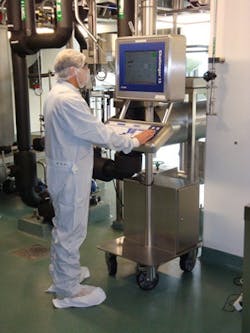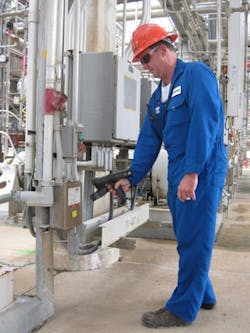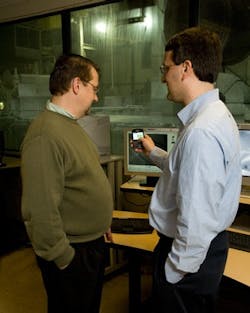By Dan Hebert, PE
The phone rings in the middle of the night. It's the third shift operator, telling you that there's been a process upset. Do you get out of bed, dress and drive 25 miles to the plant? No, instead you use your Blackberry and check what's happening, make a few changes to process setpoints and watch the system recover. Far fetched? Not at all.
Mohawk Fine Papers instituted such a system. On a Sunday afternoon at home with a single click of a Blackberry, a Mohawk engineer can tell that the paper machine is up, running at a particular speed and consuming so much energy. This is part of the "Information Everywhere" project that Mohawk implemented in 2009.
"Information everywhere is an important part of our continual improvement efforts," says Ben Whitaker, manager of enterprise process reengineering at Mohawk. "This project has played an important role in Mohawk's overall 2009 improvement in machine output, customer satisfaction and energy consumption." (To read more about Mohawk's mobile application powered by Transpara (www.Transpara.com), see the "Information Everywhere on a Blackberry") at the end of this article.
Working with Wireless
While it may not work from home, Novartis, a biotech manufacturer in Huningue, France, uses a different kind of mobile workstation to provide the flexibility needed to control their manufacturing processes.
Novartis has been using wireless since 2000. In 2008, when migrating to version 9 of Emerson Process Management's (www.emersonprocessmanagement.com) DeltaV system, the company added integrated Wi-Fi and wireless security. In 2009, Novartis expanded the wireless architecture with additional Wi-Fi access points, implementing a complete mobile wireless solution. "The most recent developments to Emerson's DeltaV system have enabled us to implement a plant-wide wireless solution," says Philippe Heitz, head of engineering.
Biotech manufacturer Novartis uses 17 mobile wireless operator workstations to control and monitor their processes. Using wireless cuts down on the total number of required workstations.
The wireless network includes 17 mobile operator stations (see Figure 1) and 100 DeltaV controllers spread over two systems. The first system controls the upstream process of cell cultivation and harvesting, and the second controls the downstream phase of purification and freezing. Both systems will soon be interconnected using DeltaV ZONE, a software and hardware solution for connecting two automation platforms.To meet the standards required for sterile zones, the mobile operator stations each have a stainless steel enclosure that houses the central processing unit. The devices are equipped with a USB connection to the usual keyboard, monitor and mouse for this type of environment. Each station connects to the network via Wi-Fi access points.
Operators can move from one level to another with their mobile station and still maintain an overview of the process. This has not only significantly improved operator efficiency, but also has made it possible to reduce the number of required workstations by 50%. A further benefit is that when a new product is being launched or a recipe changed, the mobile stations can be moved throughout the plant, obviating the need to install new operator stations.
"Because of the wireless network, we don't need to systematically invest in new control stations, even if production requires a change to the plant equipment or layout," explains Patrick Boschert, automation expert, at Novartis. "Thanks to wireless technology, Novartis cut in half the number of operator workstations required for the production area."
Another type of wireless solution doesn'- mobilize the worker, but instead the asset that is being monitored. Yokogawa (www.yokogawa.com) has implemented a wireless mobility solution for a life sciences client using 900 MHz meshing I/O radios. Their client has thousands of identical refrigeration units on a large campus. Two or three analog inputs plus a digital input are monitored on each unit.
The existing system hardwired these inputs into local data acquisition hardware, which was then collected via Ethernet over the corporate LAN by a SCADA monitoring system. These units were frequently relocated, which required rewiring of inputs and manual reassignment of tags within the SCADA database.
In the new system, a 900 mHz I/O radio is mounted with each process unit, allowing analog and digital inputs to be terminated directly on the process unit. Using the wireless network, inputs are then transmitted to centrally located wireless gateways and data concentrators. The inputs are then collected via Modbus TCP by the existing SCADA system.
Refrigeration units can now be moved anywhere on campus without making changes to the wireless network or the SCADA system database. The 900 MHz mesh network is self-organizing and self-healing, making network management more efficient.
Table PCs are the Writing on the Wall
Honeywell Automation and Control Solutions (http://acscorp.honeywell.com) has two installations where tablet PCs are being used as HMIs. Neither customer can be named, but the examples are illustrative of how the technology can be used to improve process plant operations.
The first is a refinery in Big Spring, Texas, that uses wireless to allow operators to access their operating console directly from the field via a tablet PC. Wireless also allows the plant's mobile workforce to send data collected during rounds to the automation system via handheld devices.
'The front-end design work and site assessment performed by Honeywell helped us ensure 100-percent coverage for our Wi-Fi applications and proper transfer rates to support mobile stations and handhelds throughout the refinery," says a spokesman. "Field operators were granted access to process data via a tablet PC, where they could have access to the entire control room in the facility's water treatment plant. We were able to provide field operators with key solutions at their disposal to fully control, monitor and review alarms from a tablet PC."
At a refinery in Houston, wireless technology was used to enhance the effectiveness of operators and engineers. The plant's operators needed to view real-time alarms from any location and access operating procedures, graphical displays of tank levels, pumps and other devices. The solution also had to maintain the same reliability as the control system.
Honeywell's OneWireless helped the refinery meet its safety and mitigation plan that requires response to any incident within 10 seconds. It also allowed employees to be more efficient by enabling one person to perform the tasks of many. "We looked at different options to support 15-minute response time to alarms with one operator in each of two tank farms and found it would have taken $1.25 million to make the existing approach more robust," said a control systems engineer. "Instead, we put mobile process knowledge system tablets in the operators' trucks."
Getting With the Program
The technology to support mobile workstations works just fine and has been in use for several years. Some companies—vendors and users alike—just haven't gotten with the program. An engineer who declined to be named says, "Our company has wireless solutions, but not for the automation professionals. IT handles the phones and computers, therefore they all have Blackberries. Most managers have them. Our boss is trying to get Blackberries for us, but he has been told we don't need them and they can't be justified. They are seen as a perk for managers. Since these decision-makers have no clue what automation professionals do, they see no need for us to have mobile access."
On the other hand, companies like Constellation Energy in Baltimore use a mobile system that acquires data from Transpara's Visual KPI system. "The most critical business activities in the utilities industry, such as decreasing environmental emissions or reducing outages, depend on having immediate access to pertinent operations data," says Steve Noel, director of IT, Constellation Energy. "When plant personnel check Visual KPI before doing anything else in the morning, you know it's a must-have tool."
There are still some technical barriers holding back mobile wireless solutions. "Most plants have very limited wireless network coverage," observes Harry Forbes, senior analyst at the ARC Advisory Group (www.arcweb.com).
"Many have only private networks for push-to-talk voice, and wireless LAN coverage is the exception. Lack of coverage makes the applications more difficult to use and develop. Ideally, process manufacturers would like to equip their field operators with a single device certified for use in hazardous areas that combines private push-to-talk voice communications, mobile computing and carrier data services. They can't buy something like this now, but I think it will not be much longer before they can," adds Forbes.
The mobile worker is here to stay, and the spread of wireless networks throughout process plants will hasten adoption of solutions. These solutions will increase productivity, shorten response times and improve plant safety.
AVOIDING RATTLESNAKES
Huntsman Corporation's chemical plant in Pt. Neches, Texas, is plagued with "rattlesnakes." They are hard for a maintenance technician to spot, and they are deadly. "Rattlesnakes are the unseen, unnoticed problems that can really bite you," says John Prows, vice president of manufacturing excellence at Huntsman. "You don't know when, and you don't know how―but if you don't address these problems, they will bite you."
To eliminate "rattlesnakes," Prows and his team recently undertook an aggressive manufacturing excellence program called Project Zero. Huntsman set high objectives―zero product defects, zero safety incidents and injuries, zero environmental releases and zero unscheduled downtime.
This Huntsman Corporation chemical plant operator uses a wireless handheld device to expedite his rounds, increasing his productivity and freeing time for other tasks.
To help deliver on the objectives of Project Zero, Huntsman partnered with Industrial Mobility (www.IndustrialMobility.com), Apprion (www.apprion.com) and Motorola (www.Motorola.com). They use Industrial Mobility MobilOps field mobility software to field operators to execute electronic smart rounds and checklists (see Figure 2). Field operators can enter real-time defect elimination work requests in the field, monitor and control standard operating conditions (SOCs) for each piece of equipment, and access the most up-to-date standard operating procedures (SOPs).Prows believes it's crucial to centralize and manage safety critical information in one place rather than building nested safety data into each round, checklist or procedure. The MobileOps solution contains an SOC database engine that provides safety critical data to operators and mechanics at the point of decision-making in the field. All handheld field-executable procedures, rounds and checklists pull their safety critical data from this same central source. Legacy information, such as process and instrumentation diagrams, process flow diagrams, drawings, procedures and incident reports, are also immediately available on demand in the field.
Using Motorola's MC9090 mobile computers, Huntsman personnel connect anywhere throughout the four-square mile plant via the Apprion ION System – a Class 1, Div 2-rated wireless application network. Applications include video, voice communications, energy efficiency and condition monitoring. A centralized dashboard brings together application data, wireless regional maps, equipment status views, maintenance views and reports.
Prows says Huntsman's Mobility Solution is in three units at their four-square-mile Port Neches site. "Initial results show significant improvements and indicate the goals of Project Zero will be achieved," says Prows. "With real-time wireless tracking of technician rounds activity, the number of pumps requiring daily inspection has been reduced by 50% ―allowing more time for other more crucial inspection areas." Real-time monitoring of SOCs has also led to significant process improvements and cost savings due to increased uptime and longer equipment lifetime.
"A key operational improvement was putting every unit procedure in an operator's hands while he or she is in the field," observes Kim Hoyt, manufacturing excellence manager at Huntsman. "Operators no longer have to remember the thousands of details buried in hundreds of procedures. They are available at their fingertips."
Supervisors and engineers benefit from the wireless network and the handheld devices as well. "Now, additional data on plant operations can be collected and analyzed because local instrumentation data can now be captured and stored electronically with minimal effort," Hoyt explains. "In addition, new wireless devices can be installed at a much lower cost than instruments that have to be wired into the DCS. As a start, we are looking at implementing wireless tank levels and temperatures."
Safety incidents have been reduced by over 75% and are expected to fall to zero. The mobile system has also reduced maintenance costs and increased uptime due to improvement in overall equipment effectiveness, ultimately increasing production quality and quantity.
INFORMATION EVERYWHERE ON A BLACKBERRY
Mohawk Fine Papers, a premium paper manufacturer in Cohoes, N.Y., was faced with several problems due to changes in operations. "A series of acquisitions, direct-to-consumer initiatives and expansion into new product lines caused an explosion in our finished product offering―from about 5,000 products in 2005 to about 35,000 products today," says Ben Whitaker, Manager, Enterprise Process Reengineering at Mohawk.
"At the same time, customer demands for quality and flexibility have continued to increase, and we constantly press ourselves to operate with shorter service times so that orders taken today can be in customers' hands tomorrow. Meeting these demands requires that the entire enterprise is constantly aligned and focused on key orders, key requirements, last-minute changes and what's happening on the mill floor. To coordinate these efforts, managers need a real-time view across the enterprise."
To accomplish this goal, Mohawk launched the Information Everywhere initiative to bring information from across the enterprise to users via web pages, on mobile devices and within applications. The project brings together information from control systems, production systems, inventory systems, purchasing systems, order entry systems, scheduling systems and accounting systems to provide a real-time view of the enterprise.
Mohawk Fine Papers can view key performance indicators on their Blackberries. Their wireless mobility system makes information from plant production systems visible company wide.
Mohawk implemented Transpara's (www.Transpara.com) Visual KPI as part of the overall Enterprise Intelligence initiative. Visual KPI delivers role-based, actionable key performance indicators (KPIs), scorecards and trends on any mobile device or PC. This operational intelligence and data visualization solution turns data from operations, financial and infrastructure sources into meaningful information for improved decision making from any location. "Since Mohawk was already a Blackberry environment, it was a natural fit to put Visual KPI on Blackberries," notes Whitaker (see Image 3).Visual KPI provides the mobility/data visualization component. Other technologies involved are OSIsoft's (www.Osisoft.com ) PI data historian; Microsoft SQL Server for data extraction, transformation and loading; and Microsoft Sharepoint as the information portal.
"Most of the data from the production systems are interfaced through OSI PI," explains Whitaker. "However, we have also integrated Transpara KPIs with our ERP system and various Microsoft SQL databases." Everyone in the plant has access to the data via their Blackberries including technicians, managers, supervisors, engineers and even the chief operating officer.
The project was conceived on July 1, 2009, and launched on July 16, 2009, and the Visual KPI rollout was completed on August 6, 2009. "Transpara promised that we would be up and running in less than 30 minutes," exclaims Whitaker. "That's exactly what happened."
The project played an important role in Mohawk's overall 2009 improvement in machine output, customer satisfaction and energy consumption. Supervisors and senior managers now have real-time access to machine status, production status and order status. This allows for more responsiveness to customer requirements and to manufacturing issues. In the maintenance area, supervisors and senior engineers have real-time access to energy consumption for better response to machine performance issues.
The only problem so far is that the information only goes one way. "With Transpara Visual KPI, Mohawk can effectively delivery virtually any type of information from enterprise systems to Blackberry devices. However, this communication is unidirectional and, once consumed by the wireless user, may require action and response. Increasingly, Mohawk has a need for bidirectional communications and the ability to respond," notes Whitaker.
In response to Mohawk's and other customers' requests, Transpara has recently enabled "write back" capability for the most common interfaces to data sources.
WIRELESS DOESN'T HAVE TO BE MOBILE TO WORK
Like wireless worker mobile applications, wireless monitoring of fixed assets is a method for increasing operator productivity. In both cases, operator time is saved, albeit via different methods.
Reasons To Use Mobile Devices
- Reduces number of required operator workstations
- Lets technicians tune, adjust and troubleshoot remotely
- Cuts instrument technician time when making rounds
- Gives technicians immediate access to documents and procedures
- Lets executives, supervisors and managers monitor plants remotely
- Lets control engineers solve problems remotely
Mobile Device Implementation Issues
- Wireless communications interferences within plant
- No universal wireless standard
- Not all vendors support mobile workstations
- Questionable wireless system security
- Mobile devices may not meet validation requirements
- Possible disruption from weather conditions
- Limited battery life
NV Energy's (www.nvenergy.com) Fort Churchill Generating Station in Yerington, Nev., installed a GE Energy Bently Nevada Essential Insight mesh wireless monitoring system because it didn't want its operators walking around. The problem was that a walking-around monitoring program missed too many systems, took measurements at the wrong time or didn't take enough measurements.
"Many of our less critical assets were either not monitored at all or were monitored infrequently using a walk-around data gathering regime," says Greg Bushman, plant manager. "Because several of these assets could impact plant production, they were important enough to merit an online condition monitoring system."
Another problem was the lack of data frequency when collecting data via a portable data collector (PDC) and lack of instrumentation. "Prior to the installation of the wireless system, all data for essential assets was collected using a PDC," explains Bushman. "This required technicians to perform rounds to collect data at various intervals and at certain times of the day. Because of varying temperature extremes, a particular fault may only present itself when special conditions exist. Those conditions could be the heat of the day, and if the technician is only taking measurements during the swing/evening shift, an anomaly might never be detected."
At the Persigo waster water treatment plant in Grand Junction, Colo., lift pumps in the 462-mile piping system are often miles away from the plant. If a problem came up, crews had to travel long distances to fix it. Complicating the situation, underground copper cables in the 20-year-old plant were deteriorating, degrading performance.
Ed Tankersley, lead plant mechanic, summed up the situation. "Our wires underground were failing; therefore, we were trying to get our plant-wide SCADA system running so everything in the plant would come back via wireless Ethernet. However, we had a relatively primitive communications system."
To resolve these issues, Totally Integrated Automation technology from Siemens Industry (www.usa.siemens.com) was installed. Operators can now access any process from any HMI panel in the entire plant, or from the PC operator's station in the main building. This is a big advantage, particularly in the headworks building where all the sewage comes into the plant. "That's not a place you want to spend a lot of time," Tankersley says.

Leaders relevant to this article:






